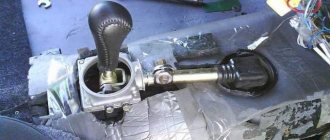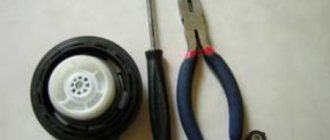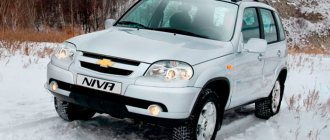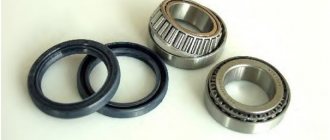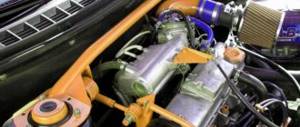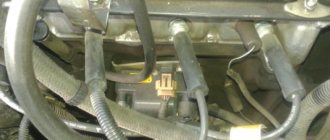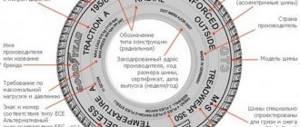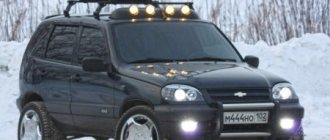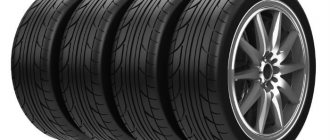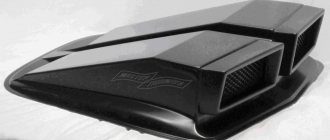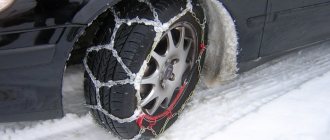As you drive, the tire tread gradually wears out. Under normal conditions, Chevrolet Niva tires can withstand a mileage of 40-50 thousand kilometers. After this, the tread height decreases. As a result of wear:
- braking distance increases;
- the car loses stability when cornering;
- When driving on a wet road, the effect of aquaplaning occurs.
Further wear causes the tire to lose strength and may burst when driving. Therefore, you need to change your tires in a timely manner and install tires that suit the weather conditions.
Preparing the Chevrolet Niva for winter
Winter tires for Shniva
In fact, any off-road vehicle is initially ready for use in difficult road conditions, incl. and in winter. The fundamental point is good winter tires. When choosing winter tires for an SUV, I recommend giving preference to tires with thinner tread and pronounced lugs. This will ensure better wheel traction in loose snow. On my Shniva I used two sets of winter tires: Bridgestone WT14 and Cooper Weather Master S/t 2. The first in size 205/75 R15, the second 215/75 R15. I really liked Bridgestone and, in my opinion, is the standard of winter tires for SUVs. Unfortunately, this model is no longer produced, although if you manage to find some leftovers somewhere, I definitely recommend purchasing it. I've been driving a Cooper Weather Master for the past few years. In general, the tires are not bad and I can also recommend them for purchase. Some time ago I wrote an article about these tires, so I recommend you read it. As for the tire pressure, during normal city use I always keep it at 2 atmospheres, just like in the summer. If there is a need to drive on loose snow for a long time or there is a risk of getting stuck, then you can lower the wheels to 1.5 atmospheres, but the main thing is not to overdo it.
Reliable battery and working generator
Few people want to find themselves somewhere far from home, in the forest, in the cold and with a car that cannot be started. In some situations, the consequences can become quite serious. And if in the warm season the poor condition of the battery or generator was completely unnoticeable, then in the winter everything can surface to the surface already at the first significant cold snap. If you have a voltmeter (the simplest one for 200 rubles will do), then I recommend measuring the voltage on the battery with the engine off and while it is running. The normal voltage of a working battery is 12.6-12.7 V. While the engine is running, the generator should consistently output 13.8-14 V with consumers turned on (stove, music, low beam). If your voltage drops to 13.5 V and below, then most likely there is a constant undercharging, which is very critical, especially with short runs. I recommend measuring voltage at the battery terminals and not relying on the voltmeter readings on the dashboard. As a rule, the latter’s indicators always differ from the real ones to a lesser extent. In addition, it will be useful to identify current leaks while the car is parked. In my case, I struggled with this for a long time, but everything turned out to be simpler - the reason was in the radio panel, which I had not removed before.
Shovel, cable, winch
During normal city use, you are unlikely to need to dig out a parking space for yourself even in the most severe snowfalls. A shovel can come in handy during out-of-town trips or to help dig out another car.
Of course, it is always recommended to carry a cable, and it is better if it is not simple, but jerky (dynamic). With the latter, it will be much easier for you to pull out a car stuck tightly in the snow. And in this case, many people love the Chevrolet Niva and as soon as they see it, they immediately call for help for the stranded one. Whether or not to help everyone you meet is a personal matter, but it’s still worth considering such a situation. Moreover, you yourself may need help.
A winch is a useful thing and indispensable in conditions of frequent winter trips to the forest. Of course, not everyone is ready to install a very expensive electric winch on their car in order to use it once or twice a year. But there is an option to purchase an inexpensive manual winch and carry it in the trunk. It is not as convenient as a stationary one and somewhat narrows your options, but, nevertheless, it is also very effective and can serve you well.
Nuances of choosing tires and wheels
Whatever manufacturer you choose, first of all you need to pay attention to the tread pattern.
The expected operating conditions of the car depend on it:
- The manufacturer installs tires with a symmetrical tread pattern without direction; if you wish, you can purchase tires with a directional tread. These wheels are suitable for driving around the city and on the highway.
- For use in more severe conditions, choose tires with an asymmetric tread pattern. A car with such wheels will be controllable on wet asphalt and in moderate off-road conditions.
- If you are going to drive outside the city, it is better to buy special mud tires. Its tread is higher and rarer. Driving on such wheels at high speeds is dangerous, plus they make a lot of noise on the highway.
Also interesting: Chevrolet Niva - price and features of the SUV
Also on the rubber there are marks on the load capacity and speed index; these parameters are standard and are suitable for all modern cars. The maximum speed of the Chevrolet Niva is 140 km/h, this value is sufficient for any wheels.
For off-road driving, it is not enough to choose a suitable vehicle. In order for a car to perform the tasks assigned to it, it must be equipped with the right tires.
Depending on the configuration, the car can be equipped with stamped steel wheels with a diameter of 15″, cast products of the same size, or wheels on 16″ alloy wheels. Standard tire sizes: 205/75R15, 205/70R15, 215/65R16. In addition, the design of the vehicle allows us to consider 195/70, 185/70 tires for installation on it. Despite the fact that these are the wheels recommended by the manufacturer, it is better to consider tires with a higher profile for an SUV.
When choosing tires for the Niva, as well as wheels, you need to know the standard parameters of the Niva wheels:
- Rim H - 6″;
- rim d – 15″;
- bolt pattern: 5 x 39.5;
- distance between the disk mounting point and the rim surface (offset) - 40 mm;
- The hole size for the hub is 98.5 mm.
The best wheels for a field in winter, according to experts, are products with parameters 215/70 R16 and speed index T or H. However, car owners usually focus on both personal preferences and financial capabilities.
Shniva and ice
Permanent all-wheel drive plays an important role when driving on any surface, incl. It helps a lot to move around in icy conditions. The Chevrolet Niva can confidently drive up a very steep icy slope and descend it by carefully braking the engine. Nevertheless, you shouldn’t think that everything is possible on Shnivy. This car is not equipped with modern stabilizing systems. As far as I know, recent models only have ABS. So Shniva has no opportunity to correct the mistakes of an inexperienced driver. Remember that the Chevrolet Niva has a very decent weight - 1400 kg, and the distance may not always be enough to quickly stop a car accelerating on a slippery road without the risk of going into an uncontrolled skid. I generally do not recommend driving the Shnivy fast at any time of the year, and especially in winter. Drive in accordance with the current road situation, do not flaunt the fact that you are driving an SUV and not some kind of pussie, keep your distance with a reserve.
The best winter tires for a Chevrolet Niva
Driving a car in winter requires increased attention from the driver due to snow drifts on the roads, ice during the mud and slush on the roads. All these weather conditions do not have a favorable effect on stability and controllability on slippery roads, so special attention should be paid to tires.
According to the recommendation of experts, for winter conditions it is better to choose tires of size 215/65R15 98H and 215/65R16 98N. We provide you with a brief overview of the most popular winter tires, based on the operating experience of experienced drivers:
- Michelin Latitude Alpin. One of the most popular brands of tires for the Chevrolet Niva 4x4 all-wheel drive SUV. Works well in conditions of sudden weather changes from thaw to frost. Price for R15 from 5200.00 rubles, for R16 from 7000.00 rubles.
- General Tire Altimax Arctic. Studded tires are well suited for roads with snow, and in the city they are stable on icy streets. Recommended for use at low temperatures. Price for R15 from RUB 3,700.00, for R16 from RUB 4,200.00.
- Nokian Hakkapelita R. The tire was specially developed for winter conditions. Velcro rubber, good handling on snowy roads and on ice, stability when driving on ice. Price for R15 from 4800.00 rubles, for R16 from 7000.00 rubles.
- Amtel Nord Master ST-310. Studded tires. At a low cost, it has quite decent characteristics when starting and stopping on bare ice.
Price for R15 from 2700.00 rubles, for R16 from 3200.00 rubles.
- Kumho I'Zen KW22. Studded tires. It behaves well on ice and snow, good handling. Many are attracted by its cost, which is lower than that of popular analogues. Price for R15 from 2800.00 rubles, for R16 from 3500.00 rubles.
Which tire to choose, studded or velcro, depends on the climatic conditions of the area, as well as the driver’s habits. If in winter the weather is constantly changing, snow will fall or melt, then priority should be given to tires with Velcro, so as not to drive with spikes on bare asphalt. And in northern regions with persistent frosty weather, it is better to take studded tires. In addition, the cost of the tire is also of no small importance; of course, everything depends on your financial capabilities.
Chevrolet Niva in the snow
The Chevrolet Niva's cross-country ability in snow is of interest to many. Of course, because this car is often purchased for trips to fishing, hunting, to the countryside and to the village, where there may be no clear roads at all. In fact, everything is not so clear here. As mentioned above, Shniva is a rather heavy car. At the same time, the engine produces (even sometimes it’s embarrassing to say) only 80 hp. Therefore, various off-road conditions, such as mud, snow, deep puddles or ruts, in general, everything where there is a risk of getting stuck, is best overcome immediately. This is not very good and in many cases can damage the car. But there is nowhere to go, and if the Shniva has stalled in deep snow, then moving off can be very problematic. Often you have to make your way by constantly moving back and forth, which is also not always easy to do. Of course, the presence of a low gear and a locking center differential come to the rescue. Without them it would be very difficult. In general, the Chevrolet Niva drives quite tolerably in deep snow until a noticeable snowdrift forms in front, which becomes difficult for it to push due to its weak engine. As for simply poorly cleaned roads, there are no problems here.
What is the difference between winter and all-season tires on a Chevrolet Niva
Many car enthusiasts believe that all-season tires are more practical and convenient because they are suitable for both summer and winter seasons. But despite this advantage, they are not intended for severe frosts, much less ice. All-season season differs from winter in several ways:
- Temperature. Winter tires can be used at any sub-zero temperature, but all-season tires become hard after -7 °C, which is unsafe.
- Braking distances. The braking distance on all-season tires is longer than on winter tires.
- Controllability on slippery roads. The tread of winter tires is deep (9-17 mm), which allows for good maneuvering during icy conditions. Tires for all seasons have treads up to 9 mm deep, which leads to certain difficulties when driving the car.
- Tread pattern. All-season tires have drainage grooves, which are good for wet asphalt, but not for snowy and icy roads. Winter tires have a large pattern.
- Rubber. The all-season version is made of a medium-soft material, and the winter version is made of a soft and porous rubber alloy.
Bottom line
To summarize, I will say that despite some of the shortcomings mentioned above, the Chevrolet Niva is a very harmonious car that is well suited for winter use in city conditions and moderate off-road conditions. She won’t be able to handle heavy off-road conditions without additional training. I do not recommend purchasing a Shniva with an eye to participating in off-road competitions; nevertheless, it is very difficult for it to compete with more powerful frame SUVs. Keep in mind that this vehicle is quite heavy and has not very effective brakes. Follow the speed limit, keep a reasonable distance and, of course, monitor the condition of the car.
YAKU1414
Chevrolet Niva can do a lot, but it's still a road...
Chevrolet Niva can do a lot, but it's still a road...
Chevrolet Niva can do a lot, but it’s still a long road...
The GM-AVTOVAZ joint venture from time to time pampers customers with so-called special series. But this is perhaps one of the most relevant - a car based on the LC modification is adapted to cold weather.
The windshield has built-in electric heating filaments. Windshield wiper blades are frameless winter ones. The standard battery 6 ST-55 has given way to a high-capacity battery 6 ST-64. The body of the SUV is painted with enamel with the self-explanatory name “Iceberg”. Have you already guessed what color it is? Bumpers, wheel arches, door sills and door trims, on the contrary, are black, made of paint-dyed plastic. A practical solution - the appearance of the car will not be spoiled by the inevitable scratches in winter due to bombardment with sand and stones and touching snowdrifts when parking. Rails are mounted on the roof of the model. The black alloy wheels are shod with 215/65 R16 Continental Conti Cross Contact AT off-road tires.
